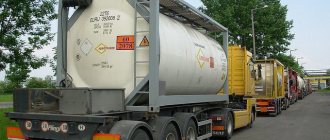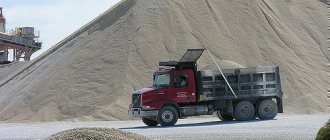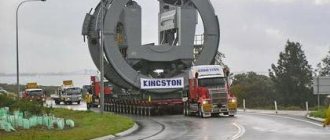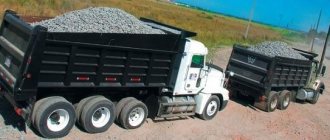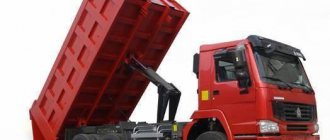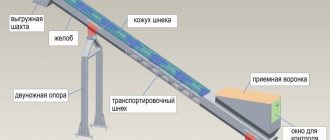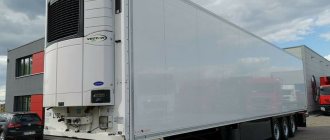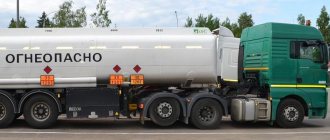Without exception, all cylinders with compressed air or more dangerous liquefied gas, according to modern legislation, belong to the category of rather dangerous transported goods. In order for the transportation of oxygen cylinders by road to be carried out correctly, the standards must be complied with. In other words, for the maximum level of safety, during the transportation process it is necessary to rely on a list of rules, conditions and norms.
Transport hazard classes
State standard 19433-88 identifies 9 classes of substances based on the degree of their danger during transportation:
- explosive materials;
- compressed gases;
- flammable liquid substances;
- solid self-igniting and flammable substances;
- substances with sufficient oxidizability and peroxides;
- cargo with toxic and infectious substances;
- radioactive substances;
- caustic cargo and corrosive substances;
- other substances with increased danger.
Rules for the transportation of gas cylinders by road
The legislator identifies the following rules according to which the transportation of gas cylinders by road for a private individual is carried out:
- cylinders are located only in a horizontal position;
- located in the body of the vehicle;
- containers must ensure that depressurization is inadmissible;
- the cylinders are separated from each other by gaskets;
- The vehicle must have fire extinguishers - carbon dioxide and powder (minimum 2 liters each).
Rules for transporting gas cylinders by car
In accordance with traffic regulations:
- cylinders must be in full working order;
- equipped with danger signs and necessary protective equipment;
- cannot exceed the specified filling volume;
- must be secured in accordance with the rules (to prevent impacts, movements - sockets, fastenings);
- transportation is carried out only in the trunk;
- carry out leak tests;
- the cargo is transported horizontally, in compliance with safety rules and taking into account road conditions.
Transporting oxygen in an unequipped vehicle
The rules stipulate that the transportation of gas cylinders with oxygen on unequipped transport is carried out under the following conditions:
- no more than 4 cylinders are transported at a time;
- located in special equipment (fenced, with gaskets between them);
- valves are laid in one direction.
Simplified procedure
In some cases, it is allowed that a truck does not meet all the requirements of ADR. We are talking about situations where the total degree in one cylinder and several will not exceed 20. The same rule applies to passenger vehicles.
We are talking not only about degrees, but also about volume, the maximum size of which is 1,000 liters. In this case, there is also no need to apply special markings or obtain an ADR certificate or other permits.
Number of oxygen cylinders that can be transported without ADR
An unlimited number of oxygen cylinders are allowed, which are transported without ADR. However, traffic police officers will pay attention to vehicles if the number of cylinders in it exceeds 15 pieces. Then employees can request permission from the driver.
How should gas cylinders be delivered:
- Transport must be specially equipped.
- The cylinders themselves must be in good condition.
- Transportation of gas cylinders is carried out in special containers with safety equipment.
- The cylinders have identification marks and inscriptions of different colors established in GOST.
- Do not fill cylinders more than the specified capacity.
- Checks are carried out before each departure and arrival on site.
When oxygen may not be dangerous
Transporting oxygen cylinders may not always be considered dangerous. If transportation is carried out in a personal car, and the total volume of gas does not exceed 40 liters, then no problems will arise. The pressure should not be higher than 200 kPa, and the temperature should not be higher than +20 °C.
In this case, the cylinder must be transported and used exclusively for one’s own needs, but in no case intended for sale. The cylinders must be securely secured so that there is not even the slightest risk of gas leakage. There will be no claims if empty oxygen containers are transported.
Legislation on the transport of cylinders
The basic requirements established for a driver who transports dangerous goods are explained by the Department for General Road Safety. If you follow these rules, the risk of receiving a fine disappears, and the chances of an emergency on the road are reduced.
Required documents when transporting propane:
- license card with appropriate marks on the cargo;
- waybill for the transportation route;
- certificate of permission to perform these works;
- emergency card;
- invoice;
- documents with contact details of persons responsible for cargo transportation.
Basic regulations
"ADR", or ADR, is the fundamental document regulating the transport of oxygen cylinders. In fact, this is an international treaty that regulates the rules throughout Europe. Other equally important regulations include:
- general rules for the transportation of road cargo, approved in 2011 by Government Decree No. 272;
- rules for the transportation of dangerous goods across the country No. 73, approved by order in 1995 (with amendments and additions);
- the manual of the Department of Motor Transport of Russia, adopted back in 1996 under No. 3112199-099096;
- rules for compliance with safety measures prescribed in Decree No. 372 dated April 23, 1994.
Additional measures for the transport of oxygen cylinders are covered in the Ministry of Transport Regulation No. 47 of 1994.
Exceptions
Certain situations do not require strict compliance with all the above prescribed standards. For example, this applies to the moment when the temperature in transported containers does not exceed twenty degrees Celsius, and the internal pressure does not exceed two bar .
These standards apply to all containers containing compressed and liquefied gas, as well as to cylinders included in the basic equipment of the vehicle. Simplified transportation rules include food and drinks containing oxygen.
It is also worth noting that with a nominal cargo capacity not exceeding a thousand liters, transportation is carried out according to simplified standards.
In this case, it is not necessary to mark the cargo and issue ADR certificates, permits and calculate the route path. Based on this, many enterprises carry out small transportations that do not require additional documentation, compared to large cargo.
We recommend! Is a Ukrainian driver's license valid in Russia?
Design features of an isothermal tank for transporting liquid oxygen:
- The tank for transporting liquefied oxygen has a cylindrical shape, a welded multilayer structure with vacuum or volumetric thermal insulation;
- the outer casing is made of steel, the intermediate layer consists of vacuum and fire-resistant insulating materials, a vessel for the transported substance is located inside;
- for additional protection from direct sunlight, the outer surface of the tank is painted in light colors and covered with a special cover;
- the internal vessel is designed for operation at excess pressure;
- pressure gauges, temperature sensors, shut-off valves, pressure safety valve are located in a special hatch in the rear part of the tank;
- fittings for filling/draining are provided in the lower part of the tank;
- The tank is equipped with a float-type level gauge.
Special requirements for tanks for the transportation of cryogenic substances - availability of a technical passport, mandatory registration with Rostechnadzor.
Placement and fastening
The containers are placed horizontally, with additionally installed safety gaskets.
Safety gaskets can be wooden blocks in which holes are cut corresponding to the dimensional parameters of the cylinder.
They hold the load, preventing movement during transport. For gaskets, ropes and rubber are also used, the thickness of which should not be less than twenty-five millimeters.
The gaskets will protect the cylinders from possible contact and impacts against each other. Cylinder valves are equipped with protective caps.
Important points
Loading and unloading of dangerous goods is carried out directly by the consignor and consignee, with mandatory compliance with transportation rules. Responsibility lies not only with the person transporting dangerous goods, but also with the transport company carrying out the transportation.
Important! The combined transportation of oxygen and propane is not recommended, especially if the car body is closed.
The vehicle can transfer as much cargo as its carrying capacity allows. Calculation of the maximum load is made depending on the condition of the roads.
Marking
The main thing to consider is that the cylinder should be colored depending not on the name of the gas, but on how dangerous it is. According to the international classification for oxygen, cylinders are painted white (RAL 9010). At the same time, in our country you can find oxygen cylinders painted blue (RAL 5012), which means oxidizing.
Each cylinder must bear the mark 5.1 or 2.2, which marks oxidizing substances. Such cargo belongs to hazard class 2 as a non-toxic, oxidizing and non-flammable gas.
Security measures
Personnel who perform loading and unloading must be trained in health and safety regulations for working with such products. The driver carrying out the transportation is required to take a course in the transportation of such substances and obtain the appropriate certificate.
According to the rules for transporting oxygen and propane cylinders by road, the containers are sealed by the manufacturer or supplier, who are responsible for proper filling. Transportation of oxygen is allowed only if the containers and the vehicle are in exceptional condition, the required inscriptions and a safety cap are present.
Cylinders are protected from exposure to high temperatures to prevent the possibility of explosion. They create conditions under which the cargo will be protected from interaction with lubricants and other materials. A spark arrester is installed on the exhaust pipe.
To alert other road users, red flags are hung on the car on the left, in front and behind.
Transportation is carried out using spring transport or trucks. They are equipped with essential equipment for extinguishing fires - two powder or carbon dioxide fire extinguishers with a capacity of 2 liters each. The body is equipped with racks with recesses, the size of which corresponds to the parameters of the cylinders. They are lined with felt inside. Locking devices are installed on the racks.
According to the rules for transporting propane and oxygen in cylinders, it is prohibited to transport people unrelated to the task at hand in the cabins of motor vehicles. Crew members should not be in the back near the cargo.
When parked at night or when driving in poor visibility, orange lights are placed on the vehicle at the front and rear.
The transportation mode should be smooth, jolts and sudden braking are not allowed. This will help avoid shaking and impacting blood vessels.
Cars with filled cylinders are allowed to be parked for more than an hour, subject to certain distances: for onboard vehicles - at a distance of 10 m and 25 m for residential and public buildings, respectively. For “cage” vehicles these limits are 20 and 40 meters.
It is prohibited to transport oxygen cylinders by vehicles containing flammable gases, including propane. Moreover, we are talking about both filled and empty containers.
If a leak is detected during a trip, the driver is obliged to stop the vehicle and act in accordance with the safety instructions.

